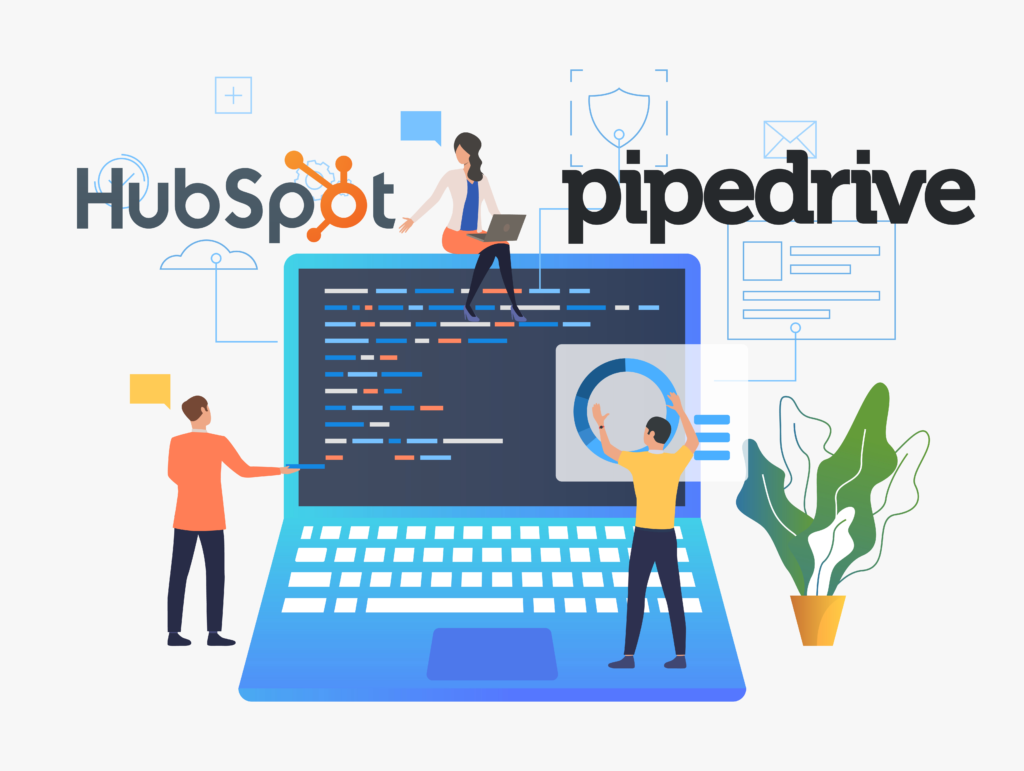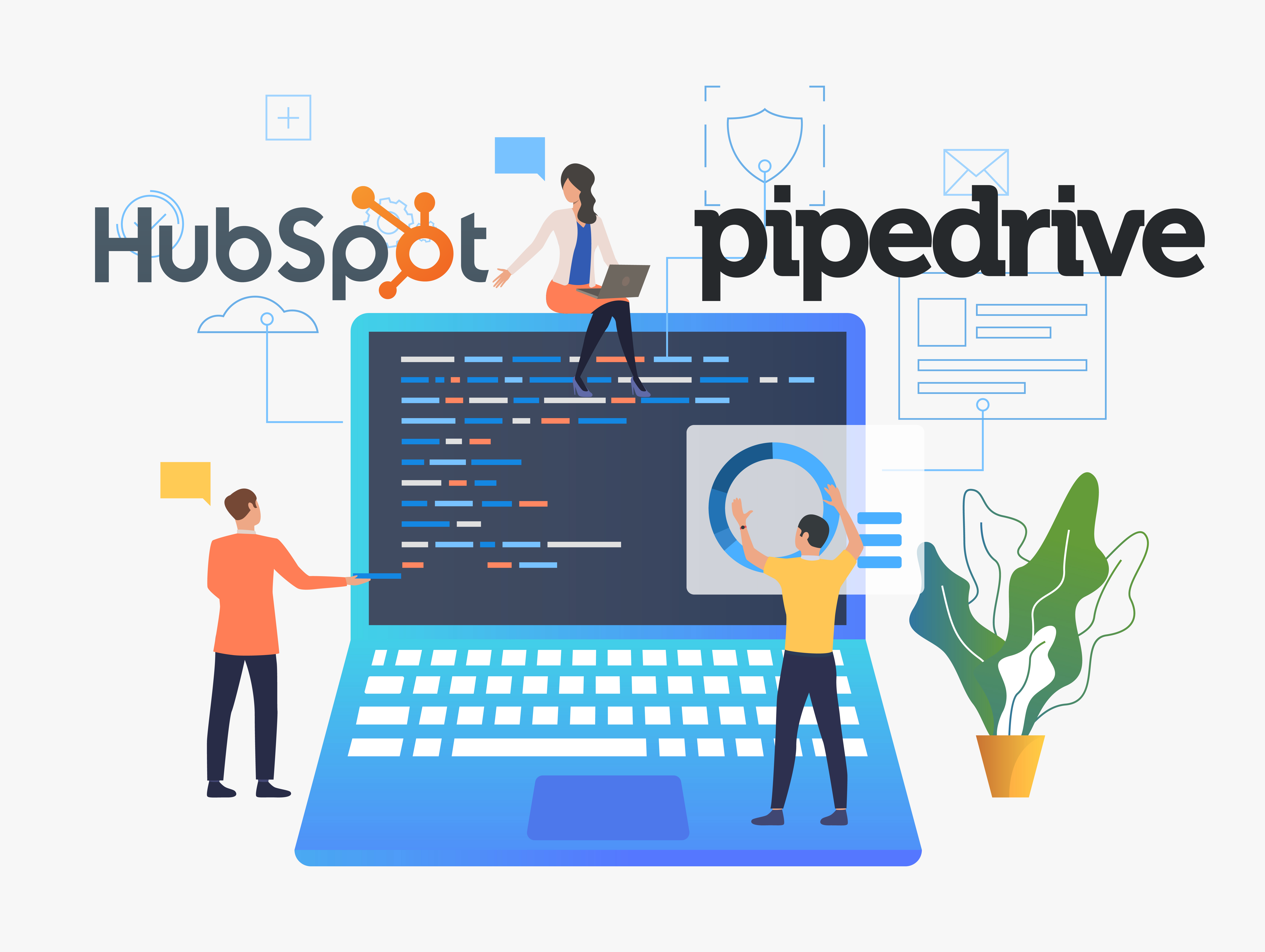When it comes to managing your customer relationship management (CRM) needs, two of the most popular tools on the market are Hubspot and Pipedrive. These platforms offer a range of features that can help you streamline your sales and marketing efforts. But which one is better suited to your business? In this article, we’ll take a closer look at Hubspot vs Pipedrive and compare their features, pricing, and user experiences.

Features: Hubspot vs Pipedrive
One of the most significant differences between Hubspot and Pipedrive is the range of features they offer. Hubspot is a comprehensive all-in-one platform that includes tools for marketing, sales, and customer service. In contrast, Pipedrive is primarily focused on sales and CRM functionality.
Hubspot features:
Marketing automation: Hubspot includes a range of marketing automation tools, including email marketing, social media management, landing pages, and lead capture forms.
Sales tools: Hubspot’s sales tools include contact management, deal tracking, sales automation, and reporting.
Customer service: Hubspot’s customer service tools include a helpdesk, knowledge base, and chatbots.
Integrations: Hubspot integrates with a range of third-party tools, including Salesforce, Gmail, and Zapier.
Pipedrive features:
Pipeline management: Pipedrive is designed to help you manage your sales pipeline, including deal tracking, sales forecasting, and activity reminders.
Sales automation: Pipedrive includes tools for automating repetitive tasks, such as email templates and reminders.
Customization: Pipedrive allows you to customize your sales pipeline to match your unique sales process.
Integrations: Pipedrive integrates with a range of third-party tools, including Zapier, Slack, and Mailchimp.
Pricing: Hubspot vs Pipedrive
Another significant difference between Hubspot and Pipedrive is their pricing models. Hubspot offers a range of pricing tiers, including a free plan, whereas Pipedrive offers a simple pricing structure with one paid plan.
Hubspot pricing:
Free: Hubspot’s free plan includes basic marketing and sales tools, including contact management, email marketing, and lead capture forms.
Starter: Hubspot’s starter plan starts at $50 per month and includes more advanced marketing and sales tools, including marketing automation and reporting.
Professional: Hubspot’s professional plan starts at $800 per month and includes more advanced features, such as custom reporting and predictive lead scoring.
Enterprise: Hubspot’s enterprise plan starts at $3,200 per month and includes even more advanced features, such as custom event reporting and revenue attribution.
Pipedrive pricing
Essential: Pipedrive’s essential plan starts at $12.50 per user per month and includes basic sales tools, such as deal tracking and contact management.
Advanced: Pipedrive’s advanced plan starts at $24.90 per user per month and includes more advanced features, such as sales forecasting and team management.
Professional: Pipedrive’s professional plan starts at $49.90 per user per month and includes even more advanced features, such as workflow automation and revenue forecasting.
User experience: Hubspot vs Pipedrive
The user experience is an essential factor to consider when choosing between Hubspot and Pipedrive. While both platforms are user-friendly, they have different approaches to usability and design.
Hubspot user experience
All-in-one platform: Hubspot’s all-in-one platform can be overwhelming for some users, as it includes a range of features and tool
Design: Hubspot has a modern and clean design that is easy on the eyes.
Training resources: Hubspot offers a range of training resources, including a knowledge base, academy courses, and certifications.
Pipedrive user experience
Sales-focused
Sales focused: Pipedrive’s user experience is tailored specifically to sales teams, making it easy for users to manage their sales pipeline and track deals.
Intuitive design: Pipedrive has a simple and intuitive design that is easy to navigate, even for users who are new to CRM software.
Training Resources: Pipedrive offers a range of training resources, including webinars, video tutorials, and a knowledge base.
Which platform is right for your business?
When it comes down to it, choosing between Hubspot and Pipedrive will depend on your business’s specific needs and budget. Hubspot is a comprehensive all-in-one platform that offers a range of marketing, sales, and customer service tools, making it an ideal choice for businesses that want an all-in-one solution.
On the other hand, Pipedrive is a sales-focused CRM platform that offers an intuitive and streamlined user experience. It’s an excellent choice for businesses that want a simple and affordable CRM tool that is tailored specifically to sales teams.
Ultimately, the best way to determine which platform is right for your business is to try them out for yourself. Both Hubspot and Pipedrive offer free trials, so you can test out their features and see which one fits your needs.
Hubspot vs Pipedrive : Conclusion
In conclusion, Hubspot and Pipedrive are two of the most popular CRM platforms on the market. While they both offer a range of features and tools, they have different approaches to pricing, features, and user experience.
Hubspot is a comprehensive all-in-one platform that includes tools for marketing, sales, and customer service. It offers a range of pricing tiers, including a free plan, making it an ideal choice for businesses that want an all-in-one solution.
Pipedrive is a sales-focused CRM platform that offers an intuitive and streamlined user experience. It offers a simple pricing structure with one paid plan, making it an excellent choice for businesses that want a simple and affordable CRM tool that is tailored specifically to sales teams.
Ultimately, the best way to choose between Hubspot and Pipedrive is to try them out for yourself and see which one fits your business’s specific needs and budget.
Other Alternative
Simply CRM is a cloud-based customer relationship management (CRM) software that is designed to help businesses manage their customer relationships and sales processes. It offers a range of features and tools that can help businesses streamline their sales processes, track customer interactions, and improve customer engagement.
One of the key features of Simply CRM is its contact management tools. The software allows businesses to store all of their customer information in one central location, making it easy to access and update customer records as needed. Businesses can also segment their customer database based on various criteria, such as demographics, purchase history, and engagement level, allowing them to target specific groups with personalized marketing campaigns.
Simply CRM also offers sales pipeline management tools that allow businesses to track their sales processes from start to finish. The software provides a visual pipeline view of all open deals, allowing businesses to see where each deal is in the sales process and identify potential bottlenecks. This can help businesses prioritize their sales activities and focus on deals that are most likely to close.
In addition to its sales pipeline management tools, Simply CRM also offers marketing automation tools that can help businesses streamline their marketing processes. The software allows businesses to create and send email campaigns, track website visitors, and monitor social media engagement, all from within the platform. This can help businesses improve their customer engagement and drive more leads and sales.
Simply CRM also offers a range of other features, including task management tools, team collaboration tools, and reporting and analytics tools. The software is designed to be easy to use, with a simple and intuitive user interface that requires no technical expertise. It also offers a range of integrations with other popular business tools, such as Zapier, Mailchimp, and QuickBooks.
Overall, Simply CRM is a powerful and versatile CRM software that can help businesses of all sizes manage their customer relationships and sales processes more effectively. Its range of features and intuitive user interface make it a popular choice for businesses looking to improve their customer engagement and drive more sales.




